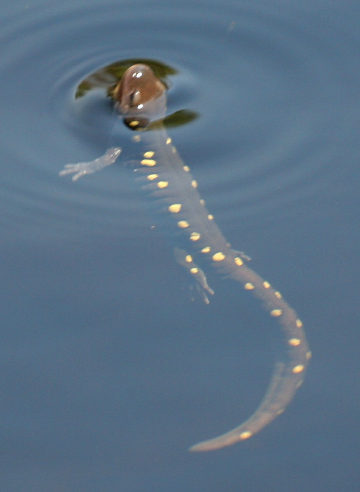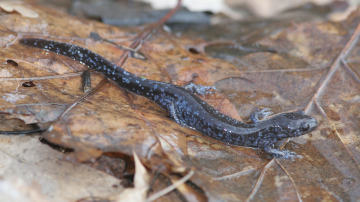Nature Notes

PHOTO COURTESY OF GARRY KESSLER
A wood frog with its distinctive black mask
March 21, 2022
NATURE NOTES
By Annie Reid
Westborough Community Land Trust
Vernal pool season
In New England, what’s so special about early spring, mid-March to mid-April? It’s the season for vernal pools, those landlocked woodland pools that fill with water in spring but dry up and disappear by late summer in most years. If you venture near one, you might see this unique environment coming to life with creatures that breed in it, sometimes even before ice is entirely gone from the water. Vernal pools don’t have fish – because the pools dry up – but their absence makes vernal pools safer for the eggs and young of numerous other animals.
Vernal pools are a hallmark of New England’s landscape and much of the glaciated northeast. Many of these spring pools were formed when retreating glaciers left behind buried blocks of ice that later melted, creating depressions in the ground, perhaps 9,000-11,000 years ago.
While walking on trails or near woods at this time of year, you might hear a loud chorus of quacking – not ducks, but frogs! Wood frogs (Lithobates sylvaticus, Rana sylvatica) are announcing their presence at vernal pools, calling for mates. They gather and call for about a week, after the first warm rainy spring nights (40+ degrees F). Wood frogs live most of the year on land in forests, where you might spot one, with its distinctive black mask. They overwinter in mud, leaf litter, or underground, often frozen nearly solid.
How do wood frogs survive freezing? Basically, in frosty autumn temperatures, their bodies start producing loads of extra sugars that draw water out of their body cells, so that freezing takes place between cells rather than inside them. Their heart stops beating and remains supercooled, along with the liver. In spring, wood frogs thaw, from the inside out, in a few hours. They start their breeding season early, racing against time to produce tadpoles that will mature before the pool dries up.

PHOTO COURTESY OF GARRY KESSLER
Fairy shrimp grow to about an inch long.
Vernal pools begin teeming with life weeks before the wood frogs come. Lengthening daylight triggers the growth of algae under the ice, and tiny bronze-colored creatures known as fairy shrimp (Eubranchipus) hatch from minute eggs that have lain dormant in the pool. As fairy shrimp feed on algae and multiply, their numbers can give the pool water an orange hue as early as February. These inch-long fairy shrimp are crustaceans, like lobsters, crayfish, crabs, water fleas, and the shrimp we eat.
Fairy shrimp are so named because they appear so suddenly – like magic, as if fairies were at work. They do their magic act thanks to the ability of their eggs to survive not only freezing in winter, but also drying in spring, baking in summer heat, and flooding in fall. Their eggs respond to harsh environmental conditions by going dormant. They shut down their life processes in an orderly fashion that makes it possible for them to start up again in an equally orderly way as conditions improve. That’s not something that we humans, or even birds’ eggs, can do.

PHOTO COURTESY OF GARRY KESSLER
A spotted salamander comes up for a breath in a vernal pool.
Many creatures use vernal pools, but wood frogs and fairy shrimp breed only in the temporary waters of vernal pools, nowhere else. The same goes for two salamanders in our area, spotted salamanders (Ambystoma maculatum) and blue-spotted salamanders (Ambystoma laterale). Vernal pools are a unique breeding habitat, important to respect and protect.
Spotted salamanders (with yellow spots) and blue-spotted salamanders are called mole salamanders because they spend much of their lives in underground burrows. They overwinter deep below the frost line so they don’t freeze. They have lungs as adults and live many years, migrating each spring to the vernal pool in which they hatched, to mate and lay eggs. Few of us get to see this night-time migration, which can put migrating salamanders and wood frogs at risk if they have to cross roads.

PHOTO COURTESY OF GARRY KESSLER
A blue-spotted salamander, protected as a species of “special concern” (SC) in Massachusetts
Vernal pools are one of our most threatened wetlands. In order to be protected under the Massachusetts Wetlands Protection Act, individual vernal pools must be certified, or registered with the Mass Natural Heritage and Endangered Species program. To find out more, see https://www.massaudubon.org/content/download/25763/423849/file/Vernal-Pools_Fact-Sheet.pdf or https://www.mass.gov/doc/guidelines-for-the-certification-of-vernal-pool-habitat/download.
To enjoy New England’s early spring while you’re indoors, check out Robert Frost’s short poem, “Spring Pools” (https://www.poemhunter.com/poem/spring-pools).